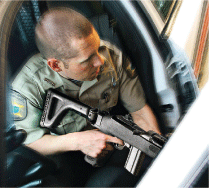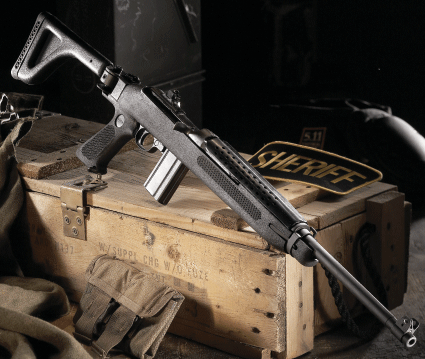While I remain a fan of the pump action 12 gauge shotgun for police work, I am very pleased with the nationwide trend towards patrol rifles. It seems that American law enforcement has finally realized that you cannot always “wait for SWAT” and that arming patrol officers with a weapon that offers greater range has its advantages. The long gun of choice for this purpose has been the AR-15 by a wide margin and I also think this is a good trend. While the weapon remains the focus of debate within the military due to several perceived disadvantages, I think the AR with its 5.56/.223 cartridge is a perfect choice for cops who do not get the practice time they should. The gun has several similarities with the autopistol as far as “running the gun” is concerned, and with modern hollow and soft point ammo the 5.56mm promises good wounding potential provided the shooter does their part. If I were working the street today, the AR-15 in some type of carbine version would be on the seat next to me.
 At the same time, there are a number of officers who for whatever reason cannot utilize the AR platform. The reasons are varied; it may be that their Chief/ Sheriff does not like the “military look” of the AR or the price of ammo is just too high for the officer or agency. A pump action weapon like the Remington 7615 might be a solution; however, something from the past might also be the way to go.
At the same time, there are a number of officers who for whatever reason cannot utilize the AR platform. The reasons are varied; it may be that their Chief/ Sheriff does not like the “military look” of the AR or the price of ammo is just too high for the officer or agency. A pump action weapon like the Remington 7615 might be a solution; however, something from the past might also be the way to go.
During WWII, the weapon of choice for soldiers and Marines was the M1 Garand for obvious reasons. It shot fast and hit hard, making it a proven performer on the battlefield. The one disadvantage of the gun was that it was rather large and heavy, which was not a big problem for the infantryman, but was a distinct disadvantage for the tanker, medic or paratrooper who had limits on how much they could carry with them into the conflict zone.
Advertisement — Continue Reading Below
Check out this article about the M1 Weapons of WWII!
The military took a hard look at the needs of these specialists and came up with a solution in the M1 Carbine. While those that used it liked its size and weight, the diminutive .30 caliber cartridge was a bit underpowered. Several WWII veterans I have spoken with over the years claim that they fixed this problem by taking the blade of their KA-BAR knife and cutting crossways into the bullet nose, thus creating a round that would fragment on impact. Today, the modern hollow point will solve this concern while its compact size and light weight are not lost on a growing number of cops.
Gun Details
Auto-Ordnance, along with its parent company Kahr Arms have taken note of this growing interest in the M1 Carbine and has recently introduced a “modernized” version of the perennial classic for law enforcement and personal defense use. Remaining true to its roots, the Tactical version offers some modern upgrades that will make the gun more appealing to the cop of the 21st century even though the design is 60-plus years old. According to records, over six million M1 Carbines were made during WWII with a mere 140,000 having a folding stock. These stocks were a thick wire configuration with a leather cheek pad, great for the time but would leave most current day law enforcement officers wanting. Like the original model, the current Tactical M1 (AOM160) is a gas operated, semi-automatic .30 caliber weapon that uses a short-stroke piston system and reciprocating operating handle. The overall length is 36.5 inches with the stock open and 27.5 with it folded. This would be a very easy gun to take in and out of a cruiser already loaded with other equipment. Unloaded the gun weighs just less than 6 pounds. The polymer stock is made by Choate for Auto-Ordnance from high strength polymer with a 0.75 of an inch vented rubber recoil pad attached. Dual sling swivels are in place fore and aft.
Advertisement — Continue Reading Below
The operating handle and trigger assemblies are also made from investment castings finished via CNC. Length of operation for the charging handle is a mere 3 inches with a very light and smooth feel. It can easily be operated with either hand.
One of the few criticisms of the gun is that the indent designed to hold the bolt open was not deep enough and it could be inadvertently released. The heat shield over the barrel offers a classic WWII look while still being quite functional. If needed, a Picatinny rail replacement can be purchased from UltiMAK that will allow the mounting of any forward mountable optic. The bolt is a two-lug configuration with the very robust extractor being located in the right side lug. The plunger style ejector is located on the inside of the recessed bolt below the extractor. Between the two, this gun sends ejected brass flying well clear of the shooter.
The barrel has a 1-in-20-inch four-groove right hand twist that later proved to be quite accurate. The blade front sight has protective ears on each side just like the guns of old. Such a classic design does not mean it’s not effective as the front sight proved to be very easy to see. If your aging eyes have trouble with it, a bit of orange paint will solve the problem nicely. The safety button is located forward of the triggerguard and is of a traditional crossbolt configuration. The magazine release button is forward of this and is large enough to push even with my small fingers. The supplied 15-round magazine locked solidly in place but released easily with a push of the button. The rear sight is a traditional flip-up peep version with two heights; one for 100 yards and closer and another for out to 300 yards. The sight is drift adjustable for windage. All in all, the Tactical M1 has everything one needs in a cruiser carbine and nothing you don’t. However, a gun is only as good as it will shoot, so the next stop was the range to see just how good this “retro-gun” would do.
Advertisement — Continue Reading Below
Shooting Impressions
I went to the range with an assortment of hollow point and ball ammo to see what the gun would do. The .30 Carbine round was never known as a “manstopper,” so being able to digest the best in ammo technology would be a real plus. As I stated earlier, those who had to rely on this gun in the past came up with unique ways to make the cartridge more effective, but current technology would now make such ingenuity unnecessary. I started out with a few boxes of 130-grain ball ammo that was given to me by a veteran who advised that it was “quite old;” nevertheless the ammo functioned flawlessly through the gun. I followed that with some 110-grain American Eagle ball that also worked flawlessly. The problem began when I tried to use CorBon DPX.
The 100-grain Barnes-X Triple-Shock X Bullet used in CorBon DPX would be the round to load into this gun for law enforcement and personal defense. With a velocity in the area of 2100 fps (feet per second), this round should prove to be very effective. The problem was, the copper bullet kept snagging on the feed ramp and would not reliably feed. I was a bit dismayed by this, so I took the gun to a local gunsmith that I trust and asked him if the gun could be throated to feed the DPX. After a thorough examination I was told that this gun could indeed be modified to work reliably with the DPX.
Realistically, this is not the fault of the gun, as it is manufactured to the original military specifications when hollow point ammo was not the norm. I would rather have the gun built as is to help keep the price down and then spend a few bucks to have it modified to my specifications than to have an overly expensive gun that could be out of reach of the normal street cop.
Advertisement — Continue Reading Below
I was able to get the gun to feed enough CorBon DPX to fire several five-round groups for accuracy at 50 yards from a bench rest. The Auto-Ordnance Tactical M1 Carbine is more than accurate enough for law enforcement or personal defense. It grouped high and to the right with all rounds. Windage was handled by drifting the rear sight, but the high groups (about 3 inches) would have to be dealt with by reconfiguring the front sight for my eyes. In any event, the gun would shoot on to a man-size target without fail, so I do not see this as a real concern.
The trigger on my test gun was really good for a stock gun, breaking my trigger scale at just over 6 pounds. The reset of the trigger was quite positive, pushing the trigger finger back out sharply making trigger control quite positive, which resulted in some very fast follow-up shots.
My range partner, “Happy Jack” Yahle and I conducted a number of combat shooting drills from standing, kneeling, prone, lateral movement and shooting while moving to see how well the compact M1 would handle. Both of us were quite pleased with the light weight and low recoil of the gun, which made moving in and out of difficult positions for two old guys all the easier.
Advertisement — Continue Reading Below
Final Notes
Would I change anything about the Tactical M1? The only thing I would change would be to screw a small piece of rail to the underside of the forward stock so that I could mount a small light like the SureFire X300 for low light situations. Other than that, I would gladly carry this gun out on the street.
























